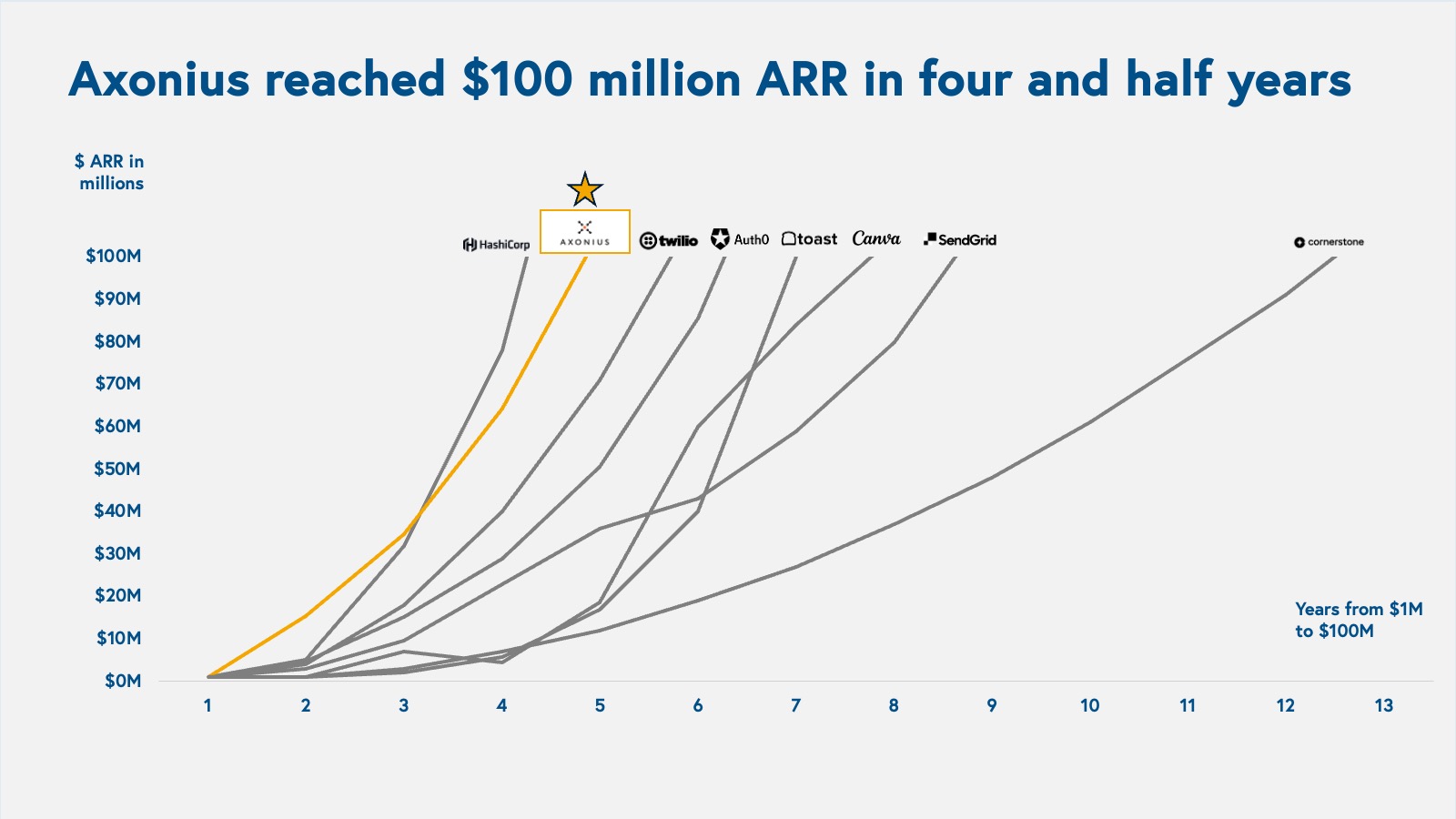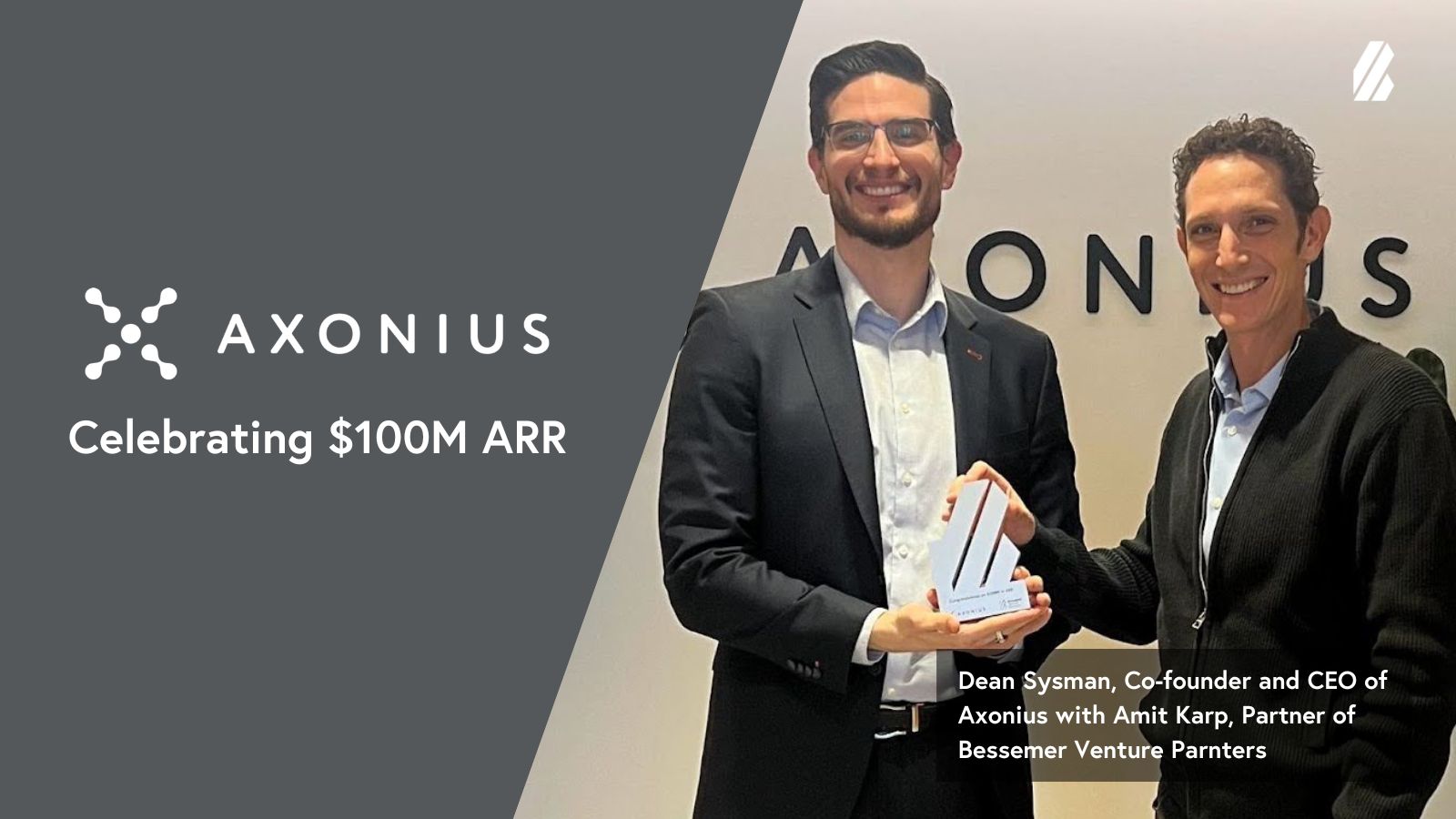Lessons from Axonius — $100 million ARR and beyond
Reflecting on how the breakout cybersecurity startup rose to Centaur status in four and a half years.
For years, we’ve been exploring the evolving state of cybersecurity and CISOs' growing demand to find comprehensive security platforms as cyber attacks keep proliferating. But my interest in the world of cybersecurity predated my time at Bessemer Venture Partners.
In 2012, I had my final project at McKinsey. Our goal was to help a large pharmaceutical company streamline their IT and software expenses, along with the software running on all devices. We were shocked to learn that the company had no consensus or source of truth for its own IT and asset management. Every department had different information, and this critical gap in their IT infrastructure reflected a broader industry challenge.
Just a few years later, I met Dean Sysman, Ofri Shur, and Avidor Bartov — an unforgettable team of entrepreneurs highly recommended for solving a seemingly obscure problem: "asset management for cybersecurity." Their mission resonated instantly with me, addressing the very problem I witnessed at McKinsey. And with time, I knew the challenge had only intensified. It was no longer confined simply to on-premise managed environments like it was in early 2010, but was now a much more complicated and dynamic environment — which also included cloud, software, SaaS applications, employee devices, many IoT devices, and more.
When Co-founder and CEO Dean Sysman presented the partnership in December 2018, he showed us how Axonius provided one comprehensive view of a cybersecurity environment and security posture of all existing assets. But most intriguing was the clever and elegant approach Axonius developed. Instead of deploying another agent on the network or endpoint, Axonius offered a unique and lightweight adaptor-based approach. It connected with existing security and management systems, aggregating their data into a single, comprehensive dashboard — like Kayak for all other security and IT tools.
Axonius showcased to other cybersecurity startups what's possible in their category.
When we invested in Axonius at the Series A in early 2019, they had only about five customers and $400,000 in ARR. But it was very clear that these customers just LOVED the product and couldn't stop using it. In a short five years, it’s been incredible to witness the team's meteoric growth, scaling their business to over $100 million in ARR.
As we recognize Axonius joining the ranks of other legendary Centaurs, I also wanted to highlight three important building lessons for other founders leading in today’s environment. The Axonius Leadership team were not just exemplary technologists, but they also showcased to other cybersecurity startups what's possible in their category.

Build something undeniably excellent, no exceptions
When you hear of a business having an NPS score of 83, you likely think of a consumer brand like Apple or Starbucks. So you’d be surprised to learn that a cybersecurity company delighted customers to the level of pulling numbers that rivaled today’s consumer earthquake startups.
Axonius’ consumer-like user experience is derived from the core of their product philosophy — to delight security practitioners with elegant solutions while solving a critical problem they encounter. Cybercrime and burgeoning cyber threats has cast a spotlight on a critical need: comprehensive visibility into an enterprise's environment. Understanding what assets exist within an organization is paramount. Without accurate and up-to-date visibility of these assets, it becomes virtually impossible to ascertain what is adequately protected and what remains vulnerable. This clarity is essential not only for immediate security, but also for formulating a robust and responsive cyber strategy.
Axonius' approach to this complex problem was both ingenious and elegant. It allowed them to demonstrate value to their customers within hours, which is rare for a security product. Rather than adding complexity, they opted for integration with existing security and management systems. Axonius’ solution is based on the underlying idea that all the information required to enable full visibility already exists across multiple security and management systems that are deployed across the organization, but with no seamless way to cross-correlate the siloed data into a single view. So instead of deploying another sensor in the network to analyze traffic, or deploying additional agents across multiple endpoints, Axonius plugs into existing security and management solutions (mostly via APIs) and aggregates their data into a single view. While the approach may seem simple, it is quite a difficult problem to solve, which is where the majority of the company’s IP lies.
Their approach to product innovation allowed for a very simple and easy deployment, as Axonius only needed the credentials to other security and IT systems to immediately provide full visibility and generate a wow effect. Security teams could suddenly and easily answer questions which were impossible to answer before without major manual effort. Simple questions like, “How many machines I have connected onto my enterprise network?”, and “Which ones don’t have the latest patch of CrowdStrike installed?” were impossible to answer before without manually tapping into four or five different systems and trying to correlate the data between them which would require a major effort.
Build a startup within a startup
With its commitment to innovation at the core of Axonius’ DNA, Dean and the leadership team set out to build an innovation arm. For most businesses, internal ventures like this happen at the later stage, but in Axonius’ case, they set out to build a separate business unit focused on research and product development for next generation products.
In 2021, the team realized the power of their underlying platform and launched AxoniusX, led by entrepreneur Amir Ofek at the helm as CEO, with the purpose to explore new market opportunities and applications of Axonius technology, and then bring them to market. Together, he hired a founding team to explore and develop solutions for emerging IT and security challenges, enabling the business to fully support current customers and their changing needs.
Many early stage founders try to build their second or third acts within the existing organization, often leading to de-prioritizing them over near-term product roadmap and supporting the existing customer base. Axonius realized the benefit of having a dedicated and experienced team focused only on future opportunities, which will be separate from the core team yet will work closely together. And indeed, less than a year ago, the team launched a SaaS Management product. It’s already growing very fast, and could one day be a unicorn by itself if it was an independent company. This is very encouraging, as Axonius’ single platform vision will provide more and more products in a unified and easy to consume approach to solve the ever growing security needs.
What has been evident through this innovation arm during its early phase is that, while Axonius mostly caters the security team, it is already used by other groups in the organization such as IT, Legal and Finance. Axonius has become the “system of record” where organizations manage their entire assets. This creates a real opportunity to build an enduring, standalone company — something rare in the cyber universe, which tends to skew towards niche products.
Build a culture of mentorship to drive the flywheel of innovation
Since its earliest innings, Dean knew the importance of making sure everyone on the team had someone they could learn from, confide in, and aspire to be more like. Building a culture of mentorship has been a prevailing thread throughout the trajectory of Axonius’s growth. In fact, all executives get mentorship, and for good reason — promoting people from within and giving them a path for growth is what continues to sharpen your edge in a highly competitive and crowded market, such as cybersecurity.
As we’ve often championed at Bessemer, people are the drivers of technology and talent recruitment. Engagement is the most critical priority for any CEO to focus on during his tenure.
The Axonius founders have always championed that development is superior when it happens “in house.” They’ve demonstrated how prioritizing industry innovation, always, is what helps attain and keep you as a market leader. They constantly prioritize smart and ambitious up and comers with strong cultural fit over anything else.
Built by a legendary founding team
Every early stage investment depends on the excellence of the team.
At Bessemer, we always knew Dean, Ofri and Avidor were unique — in our many references, people who served with them in the special units of 8200 referred to them as rockstars. They were always considered the smartest among what was already a very smart and capable group. But seeing them grow and develop so quickly over the past five years was even more remarkable.
It goes without saying that when you see a founder and CEO navigate a company through a number of global crises, it illustrates the quality and excellence of leadership. From a worldwide pandemic in early 2020, to the burst of the COVID tech bubble that followed, to a war in Israel where most of the R&D team resides, these true catastrophic conditions never deterred Axonius from staying true to their mission — helping businesses control cybersecurity complexity in today’s digital world.
In the short amount of time they’ve scaled from $1 million to over $100 million ARR (best-in-class), the team has raised $595 million in funding with a valuation of $2.6 billion. Accolades from Forbes Cloud 100 list, Deloitte Technology Fast 500™, and beyond merely validate the indelible change they’ve made in cybersecurity. With this kind of growth trajectory — including a unique product, natural expansion opportunities, and an ambitious team — who knows what the future holds for Axonius. We can’t wait to see what’s on the horizon.



